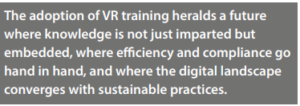Conventional Training Vs Virtual Reality (VR) training
Why Pharma Industry Need to Look Beyond Conventional Training?

By Subrata Chakraborty
The pharmaceutical industry stands at a crossroads, facing unpreced ented challenges in an era marked by rapid technological evolution and stringent regulator y landscapes. As the industry grapples with the complexities of modern drug development, manufacturing, and continuously evolving quality standards, the role of its workforce becomes pivotal. According to a report by McKinsey1, the industry is undergoing a rapid transformation that requires new skills and capabilities, such as digital and data literacy, agile ways of working, and an innovation mindset.
The pharmaceutical industry stands at a crossroads, facing unprecedented challenges in an era marked by rapid technological evolution and stringent regulatory landscapes. As the industry grapples with the complexities of modern drug development, manufacturing, and continuously evolving quality standards, the role of its workforce becomes pivotal. According to a report by McKinsey1, the industry is undergoing a rapid transformation that requires new skills and capabilities, such as digital and data literacy, agile ways of working, and an innovation mindset. Conventional training methods such as self-study of SOPs or classroom training, which were once thought to be the cornerstone of pharmaceutical education, are now showing their limitations in addressing the complex problems encountered on the shop floor.
Despite substantial annual investments in training employees, the industry finds itself entangled in a web of people practice/competency issues on the shop floor. These issues, ranging from lapses in adherence to aseptic procedures to critical deviations in manufacturing protocols, underscore a glaring gap between theoretical knowledge and its practical application. The consequence of this gap is not only operational inefficiency but, more critically, compromising with established quality and regulatory standards and potentially causing a threat to patient safety. It is a testament to the shortcomings of conventional training in instilling the precision and application-oriented skills demanded by the industry’s dynamic landscape.
With these frequent failures at the shopfloor, an unabated stream of regulatory citations, and the increased focus on people aspects in the recent regulatory guidance (e.g., new EU Annex -1)2, there’s a growing recognition that a paradigm shift in training methodologies is imperative. It’s an urgent need for a more effective, adaptive, and impactful approach to preparing its workforce. In this context, emerging technologies, particularly Virtual Reality (VR) and simulation-based training, are emerging as beacons of innovation capable of bridging the gap between theory and practice on the shop floor.
In this article let us understand the limitations of conventional training, delving into the intricate challenges faced by the industry, and learn about a forward-looking, technology-infused approach that promises to redefine pharmaceutical training in the years to come.
The Static Nature of Training
Conventional training methods in the pharmaceutical industry have long been characterized by a static and standardized approach. This rigidity poses a significant challenge in addressing the diverse and dynamic needs of a sector that is continually evolving due to technological advancements, regulatory updates, and shifting global health landscapes.
Traditional training often adheres to a uniform curriculum, assuming a homogenous workforce with identical learning needs. In reality, the pharmaceutical industry encompasses a spectrum of roles, from laboratory technicians to regulatory affairs specialists. A singular, standardized training model fails to cater to the distinct learning requirements and job responsibilities of this diverse workforce.
Static training models also lack adaptability to individual learning styles, paces, and preferences. Different individuals within the industry absorb information differently. Some may excel in a traditional classroom setting, while others may benefit more from interactive and hands-on approaches. A static model fails to tailor the learning experience to these varied needs.
The pharmaceutical industry is witnessing a paradigm shift with the emergence of novel roles, say for example, those at the intersection of biology and technology. Conventional training, often designed years ago, may not align with the specific skill sets required for these emerging roles. The static nature hampers the industry’s ability to swiftly adapt to these changes.
 Further, the training content in conventional models may become outdated as regulations evolve, technologies advance and global benchmarks rise. Professionals trained with outdated information may not be adequately equipped to navigate the current regulatory landscape or leverage the latest technologies, or current industry benchmarks, leading to potential inefficiencies and compliance gaps.
Further, the training content in conventional models may become outdated as regulations evolve, technologies advance and global benchmarks rise. Professionals trained with outdated information may not be adequately equipped to navigate the current regulatory landscape or leverage the latest technologies, or current industry benchmarks, leading to potential inefficiencies and compliance gaps.
Managing the Knowledge Retention
In the realm of pharmaceutical training, where the stakes are high and precision is paramount, knowledge retention plays a pivotal role. The concept of the “forgetfulness curve” is a psychological principle that illustrates how information is quickly forgotten if not reinforced. In the context of pharmaceutical training, this phenomenon has significant implications for the competence and performance of professionals.
 The forgetting curve3, based on the pioneering work of psychologist Hermann Ebbinghaus, demonstrates that learners tend to forget the majority of what they’ve learned in a short period unless the information is reinforced. In the pharmaceutical industry, where adherence to protocols, knowledge of regulatory standards, and understanding of complex processes are crucial, the forgetting curve underscores the need for training methodologies that counteract this natural tendency. Traditional training often involves lengthy classroom sessions, PowerPoint presentations, and passive learning. These methods, while providing information, may not be optimized for long-term retention. The forgetfulness curve suggests that a significant portion of the material covered in such sessions may be forgotten rapidly.
The forgetting curve3, based on the pioneering work of psychologist Hermann Ebbinghaus, demonstrates that learners tend to forget the majority of what they’ve learned in a short period unless the information is reinforced. In the pharmaceutical industry, where adherence to protocols, knowledge of regulatory standards, and understanding of complex processes are crucial, the forgetting curve underscores the need for training methodologies that counteract this natural tendency. Traditional training often involves lengthy classroom sessions, PowerPoint presentations, and passive learning. These methods, while providing information, may not be optimized for long-term retention. The forgetfulness curve suggests that a significant portion of the material covered in such sessions may be forgotten rapidly.
Beyond conventional training, the incorporation of interactive and immersive learning experiences addresses the forgetfulness curve. The Virtual reality (VR) and simulation-based training, for instance, can create scenarios where learners actively engage with the material. This active participation, combined with a realistic and immersive environment, enhances knowledge retention. Knowledge retention is significantly improved through repetition and reinforcement. Interactive modules that require learners to revisit and apply their knowledge in various scenarios provide the necessary repetition. This repetition strengthens neural connections and contributes to more enduring memory. All of this occurs without the need for additional time because of the intrinsic value of virtual reality, which speeds up the learning process by allowing trainees to absorb the contents more quickly.
Further a Continuous Assessments and Feedback throughout the training process which includes immediate feedback on performance allows learners to identify areas of weakness and reinforces correct responses. This iterative process contributes to ongoing learning and retention.
Virtual reality (VR) training works by tailoring the learning paths to individual needs and roles. This customization ensures that trainees focus on areas directly relevant to their responsibilities, enhancing the effectiveness of the training and, consequently, the retention of critical knowledge. Professionals who retain and can readily apply knowledge contribute to a culture of excellence, reduce the likelihood of errors, and enhance overall operational efficiency in the pharmaceutical industry.
Regulatory Compliance vs. Practical Application and skill building
In the pharmaceutical industry, training has traditionally been geared heavily towards ensuring regulatory compliance. While compliance is non-negotiable and forms the bedrock of industry operations, an overemphasis on it at the expense of practical application can lead to a workforce that is adept at ticking boxes, but perhaps less skilled in navigating the real-world complexities of pharmaceutical processes. Conventional training often involves rote memorization of regulations and guidelines. Employees may memorize the required standards without truly understanding the underlying principles or their practical applications. A compliance-centric approach might not encourage employees to engage in critical thinking or problem-solving. The focus may be on adhering to established norms without necessarily understanding the rationale behind them.
 Practical application-oriented training emphasizes not just the “what” but the “why” and “how” of pharmaceutical processes. Employees gain a deeper understanding of the scientific and operational aspects of their work. Training that encourages practical application hones problem-solving skills. Employees learn to apply their knowledge to address real-world challenges, fostering a proactive and solutions-oriented mindset. Also, a practical training equips employees to be adaptable. They are better prepared to handle unexpected situations, deviations from the standards, and the evolving challenges of the industry.
Practical application-oriented training emphasizes not just the “what” but the “why” and “how” of pharmaceutical processes. Employees gain a deeper understanding of the scientific and operational aspects of their work. Training that encourages practical application hones problem-solving skills. Employees learn to apply their knowledge to address real-world challenges, fostering a proactive and solutions-oriented mindset. Also, a practical training equips employees to be adaptable. They are better prepared to handle unexpected situations, deviations from the standards, and the evolving challenges of the industry.
Virtual Reality (VR) training represents a paradigm shift from conventional training methods. It offers an immersive and interactive learning experience that goes beyond textbooks and classroom settings. VR allows for the creation of highly realistic simulations of pharmaceutical environments. This realism provides employees with a virtual laboratory or manufacturing setting where they can apply their knowledge in a lifelike context. Unlike traditional training, VR offers a hands-on experience. Employees can interact with virtual equipment, conduct experiments, and navigate through processes, replicating the tactile and practical aspects of their work. VR creates a risk-free learning environment. Employees can make mistakes and learn from them without the potential consequences associated with real-world errors, enhancing skill-building in a safe space. VR platforms also adapt to the individual learning needs of employees. The technology can track progress, identify areas of strength and weakness, and tailor the learning experience to address specific skill gaps.
Limitations of Training Evaluation
Conventional training often rely on static assessment methods which lack depth and fail to provide a nuanced understanding of an employee’s actual capabilities or the effectiveness of the training program. They may not capture the application of knowledge in real-world scenarios, which is crucial in industries like pharmaceuticals where practical skills on the shop floor are as important as theoretical knowledge. Conventional assessments may not effectively measure the application of learned concepts. Knowing theories doesn’t necessarily translate to the ability to apply them in complex, real-world situations—a critical skill in pharmaceutical settings.
Further the traditional post-training evaluations are often one-time events. They miss the ongoing assessment needed for continuous improvement. Training effectiveness should be a dynamic process, adapting as employees apply their knowledge and skills over time. The in-depth understanding of an employee’s advancements, areas of struggle, or evolving capabilities is often overlooked, hindering the ability to tailor training for continuous improvement.
Another important area is a feedback loop. Without feedback, employees lack guidance on how to improve, and the organization misses valuable insights into the effectiveness of its training programs. Real-time feedback on the other hand introduces dynamic assessment methods. Continuous evaluation methods, such as scenario-based assessments, and interactive simulations, provide a more comprehensive and accurate measure of employee capabilities. It also offers a holistic understanding of performance.
VR training go beyond mere facts, it assesses how well employees can apply their knowledge, problem-solve, and adapt to various scenarios, creating a more nuanced picture of their capabilities. Its Real-time feedback generates rich, actionable data. Leaders can make data-driven decisions, ensuring that training investments align with organizational goals and contribute to ongoing success.

Digitalization of Training
Conventional training modes usually need hard copy documentation or manual keying in of the training data. This reliance on physical paperwork not only consumes time but can also introduce errors and inefficiencies. In contrast, Virtual Reality (VR) training offers a transformative advantage in the realm of digitalization by seamlessly automating the generation of training records.
VR platforms can automatically capture and record user interactions and performance. This eliminates the need for manual record-keeping, ensuring accurate and real-time documentation of each learner’s progress and achievements. It integrates with digital platforms for streamlined data management. This not only reduces administrative overhead but also enhances the accessibility and security of training records. The digital nature of VR facilitates prompt updates in response to regulatory changes.
 VR training reduces the need for paper-based documentation. This aligns with sustainability goals, contributing to a greener approach to training and minimizing the environmental footprint associated with conventional modes.
VR training reduces the need for paper-based documentation. This aligns with sustainability goals, contributing to a greener approach to training and minimizing the environmental footprint associated with conventional modes.
Conclusion
In the pharmaceutical industry’s journey toward excellence, the adoption of Virtual Reality (VR) training is emerging as a transformative force, reshaping learning paradigms and fortifying organizational capabilities. VR transcends the limitations of conventional training modes, offering a comprehensive suite of benefits that reverberate across efficiency, compliance, and sustainability. The unparalleled advantage of VR lies in its capacity to enhance knowledge retention, providing a dynamic and immersive learning environment. This not only empowers employees with a profound understanding of complex processes but also cultivates a culture of continuous improvement.
Efficiency gains are evident on the shop floor, where VR acts as a guardian against human errors. By placing learners in realistic scenarios, it instils practical skills and judgment, reducing the likelihood of costly mistakes. Real-time feedback further fine-tunes performance, fostering a proactive approach to risk management.
The digital prowess of VR extends beyond training modules. The automatic generation of training records eliminates the cumbersome reliance on hard copy documentation, streamlining data management. This not only ensures accuracy but also provides real-time insights for informed decision-making. In an era where environmental sustainability is paramount, VR stands as a champion. By significantly reducing paper usage, VR aligns with corporate responsibility goals, offering a green alternative to conventional training modes.
In conclusion, the adoption of VR training heralds a future where knowledge is not just imparted but embedded, where efficiency and compliance go hand in hand, and where the digital landscape converges with sustainable practices. It’s not merely a training evolution; it’s a strategic investment for a resilient, agile, and future-ready pharmaceutical industry.
References:
1. Emerging from disruption: The future of pharma operations strategy, By Hillary Dukart, Laurie Lanoue, Mariel Rezende, and Paul Rutten. McKinsey & Company.
2. EU Annex-1, Manufacture of Sterile Medicinal Products.
3. Ebbinghaus’s Forgetting Curve, By Hermann Ebbinghaus, The MindTools Content.
4. What does virtual reality and the metaverse mean for training? By PwC.
 About The Author
About The Author
Subrata Chakraborty, the Founder and CEO of INOVR, a Virtual Reality-based educational platform, designed exclusively for the pharmaceutical industry. With 27+ years in Manufacturing, Quality operations, Validations, and Training, he’s an expert in Aseptic Processing and contamination controls. Beyond his SME role, Subrata significantly impacted people and organizational development during his decade- plus leadership roles at Pfizer, Novartis, Fresenius- Kabi, and Cipla. Recognized for his expertise, he actively contributes as an author, speaker, and technical reviewer in global industry forums like PDA, ISPE, and SfSAP. Subrata’s multifaceted career exemplifies his commitment to advancing pharmaceutical education and industry standards.
He can be reached at –
[email protected] or
https://www.linkedin.com/in/subratac/
Learn about INOVR at: https://www.inovr.org/







